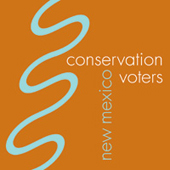Wednesday, March 26, 2008
National Congress of American Indians Seeks Applicants for National Native Vote Coordinator
 The National Congress of American Indians is seeking qualified applicants for the salaried position of National Native Vote Coordinator for a national bi-partisan GOTV campaign. For more information on the job and how to apply, click here. The 2008 Native Vote initiative is an extensive national non-partisan effort to mobilize the American Indian and Alaska Native vote in collaboration with regional organizations, local tribal governments, centers serving the Indian populations of urban areas, and non-governmental organizations whose focus is on democracy initiatives.
The National Congress of American Indians is seeking qualified applicants for the salaried position of National Native Vote Coordinator for a national bi-partisan GOTV campaign. For more information on the job and how to apply, click here. The 2008 Native Vote initiative is an extensive national non-partisan effort to mobilize the American Indian and Alaska Native vote in collaboration with regional organizations, local tribal governments, centers serving the Indian populations of urban areas, and non-governmental organizations whose focus is on democracy initiatives.
March 26, 2008 at 01:40 PM in Native Americans | Permalink | Comments (0)
Wednesday, February 27, 2008
Udall Asks Pelosi to Move Indian Health Bill to Top of House Agenda
In a statement released yesterday after the long-awaited Senate passage of the Indian Health Care Improvement Act, US Rep. Tom Udall (D, NM-03), urged House Speaker Nancy Pelosi to move the bill to the top of the House’s agenda.
“Our nation’s health care system is badly in need of reform,” Udall wrote in a letter to Pelosi. “But nowhere is the issue of inadequate healthcare more acute and in need of improvement than on Native American lands and in the Indian Health Service agency.”
The legislation, which passed the Senate today by a vote of 83-10, is the first substantial overhaul of the Indian health care system in over a decade. It would provide medical care to approximately 1.8 million American Indians and would authorize spending for the Indian Health Service (IHS) for the next 10 years.
Udall acknowledges the legislation does not remedy all of the wide-reaching problems in Indian Country, however, passing the bill will mark huge progress. “While S. 1200 is not a panacea that would immediately fix every one of the problems plaguing the access to care and the quality of care for Native Americans, it is an important and long overdue step towards modernizing the Indian health care system,” he wrote.
To read the full text of Udall’s letter click here.
According to published studies from the US Indian Health Service, IHS-served populations generally suffer from a higher incidence of illness and premature death rates than the U.S. population as a whole. The study indicates that in comparison with the general population, American Indians are 6.5 times more likely to die from alcoholism, 6 times more likely to die from tuberculosis, almost three times more likely to die from diabetes and 2.5 times more likely to die in accidents. To see the full study, click here.
Udall represents a district that is 19 percent Native American. He serves a Co-Vice Chair of the Congressional Native American Caucus and is a member of the Appropriations Subcommittee on Interior and the Environment, which appropriates funding for the Indian Health Service.
February 27, 2008 at 08:58 AM in Healthcare, Native Americans | Permalink | Comments (0)
Monday, January 21, 2008
Report Says Clean Energy Better for Navajo Economic Development than Desert Rock
Diné Citizens Against Ruining Our Environment (Diné CARE) held a press conference in Santa Fe on Friday, January 18, 2008 and released a new report that spells out a host of renewable energy alternatives to Desert Rock, a controversial coal-fired power plant proposed for the Navajo Reservation. Dine CARE and other environmental groups have argued that Desert Rock, which would be the third coal-fired plant in the Four Corners region, would harm the environment and residents' health
The comprehensive report contains more than 160 pages and dozens of maps, pie charts and graphs showing how renewable energy projects would compare to Desert Rock. It also provides a comprehensive look at how the tribe's Diné Fundamental Law—based on centuries of customary, traditional, natural and common law—can be applied to the modern problems of resource management and energy development.
Investing in renewable energy development and energy efficiency could provide more jobs and economic benefits for the Navajo Nation than building the proposed $3 billion Desert Rock Energy Project, according to the economic analysis, prepared in consultation with Ecos Consulting.
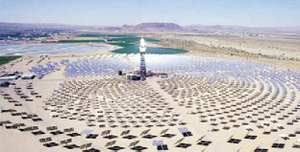
Solar power plant design prototype
The report compares sources of clean energy, such as solar and wind power, with coal, assessing economic factors such as short- and long-term employment, financial risks, environmental and health impacts, potential costs of carbon pollution, and profitability for the tribe. When the estimated economic benefits and costs of the proposed 1,500-megawatt pulverized coal power plant are weighed against benefits and costs of renewable energy development, the analysis determined that “developing clean-energy resources rather than coal provides a net economic advantage.”
 “Wind, solar and energy-efficiency technologies, which are cost-effective, reliable and available, would provide greater Navajo economic development and lower cost electricity than Desert Rock, with fewer negative consequences and more sustainable benefits,” concluded Ecos Consulting co-author Chris Calwell. “Burning coal to produce electricity is not even the best, let alone the only form of economic development for the Navajo Nation.”
“Wind, solar and energy-efficiency technologies, which are cost-effective, reliable and available, would provide greater Navajo economic development and lower cost electricity than Desert Rock, with fewer negative consequences and more sustainable benefits,” concluded Ecos Consulting co-author Chris Calwell. “Burning coal to produce electricity is not even the best, let alone the only form of economic development for the Navajo Nation.”
This claim counters the assumptions in the recent Draft Environmental Impact Statement on Desert Rock prepared by the U.S. Bureau of Indian Affairs. The federal government’s analysis predetermined the need to use Navajo coal resources without considering alternative forms of economic development and energy resources already available to the tribe.
The report states that Northern Arizona University found potential wind capacity on tribal lands in northeastern Arizona to be over 11,000 megawatts. There's also the possibility of more than 48,000 megawatts of solar generation on Navajo land, according to the report.
Click to read the entire release.
To obtain a copy of the report by Ecos Consulting, please send an email to:
- Dailan Long, email: dailan.jake@gmail.com
- Lori Goodman, email: kiyaani@frontier.net
To keep current or to get involved in activism on this issue, visit the Desert-Rock-Blog and the website of Diné CARE.
You can find some of our previous coverage of this issue here and here, including links to additional posts and other sources of information.
January 21, 2008 at 10:29 AM in Energy, Environment, Local Politics, Native Americans | Permalink | Comments (0)
Friday, January 11, 2008
NM-01: Pueblo of Jemez Endorses Heinrich
![]() From Martin Heinrich for Congress:
From Martin Heinrich for Congress:
Heinrich: "My campaign is about changing the way Washington works, and I am proud to have the support of the Pueblo of Jemez as we move forward"
Former Albuquerque City Councilor and Democratic candidate for Congress Martin Heinrich picked up another endorsement today in his campaign to bring change to Washington. The Pueblo of Jemez has endorsed his bid to represent New Mexico's First Congressional District. The Pueblo of Jemez is Heinrich’s second tribal endorsement as the Pueblo of Zia endorsed Heinrich in November.
"I am honored to have the support of the Pueblo of Jemez. New Mexico has a long history of elected officials who have proven to be effective advocates on tribal issues and I intend to continue that tradition. My door will always be open to New Mexico’s pueblos and tribes as well as the members who reside in CD-1.” Heinrich said.
While the Pueblo of Jemez is outside the boundaries of District 1, many members of Jemez Pueblo reside in the district, particularly in Albuquerque. In addition, the Pueblo has a long history of working closely with New Mexico's entire congressional delegation on matters important to the Pueblo and all New Mexicans.
Over the course of the campaign to date, Heinrich has amassed an impressive number of endorsements from community leaders and elected officials across the First District. Heinrich's backers include two state senators, five state representatives, five Albuquerque city councilors, and many other elected officials. For a full list of Martin's endorsements, click here.
To read our previous coverage of the 2008 NM-01 Congressional race, visit our archive.
January 11, 2008 at 02:41 PM in Native Americans, NM-01 Congressional Seat 2008 | Permalink | Comments (0)
Bingaman & Udall Urge Funding of Galisteo Basin Study, Ask County to Delay Leases
The Santa Fe County Commission will hold its first public hearing on their proposed new oil and gas drilling ordinance on January 22, at 3:00 PM in Santa Fe Community College’s Jemez room. A second public hearing is set for February 12 at 6:00 PM in the County Commission chambers.
In the meantime, two of New Mexico's members of Congress are working on another aspect of protecting New Mexico's unique treasures from potential damage from Tecton's proposed drilling in the Galisteo Basin, and have issued this statement:
WASHINGTON - U.S. Senator Jeff Bingaman and Representative Tom Udall are pressing the Bush administration for funding to produce an archaeological management plan for the Galisteo Basin, which is home to the largest ruins of Pueblo Indian settlements in the United States, spectacular examples of Native American rock art, and ruins of Spanish colonial settlements.
Simultaneously, the lawmakers have asked the Santa Fe County Commission to delay the issuance of drilling leases in the area until the management plan is completed.
In a letter to Office of Management and Budget Director Jim Nussle, Bingaman and Udall cite the Galisteo Basin Archaeological Sites Protection Act, legislation they sponsored, which became Public Law No: 108-208 on March 19, 2004. Their legislation requires the Secretary of Interior to undertake a comprehensive study of the archeological assets of the basin and to determine what actions are
needed to protect them.
In their letter to Nussle, the lawmakers said, "We included this language because we know we have only just begun to take stock of all the prehistoric and historic archeological resources in this area yet they are constantly under threat of ruin by natural causes, urban development, vandalism, and uncontrolled excavations."
Bingaman and Udall expressed their deep concern that nearly four years after their legislation was enacted no funds have been proposed or released to recommend new areas for protection or to develop a management plan. They pressed Nussle to adequately fund the study, as directed by law, in fiscal year 2009.
In a separate letter to Santa Fe County Commissioners, Bingaman and Udall also urge the Santa Fe County Commission to "delay issuing leases for any activities, such as exploration or drilling, that have the clear potential to permanently disturb or destroy irreplaceable historic artifacts in the Galisteo Basin."
Text of the letters to both Director Nussle and the Santa Fe County Commission are included below.
Jim Nussle
Director, Office of Management and Budget
725 17th Street, NW
Washington, DC 20503
Dear Director Nussle,
We are writing with regard to the Galisteo Basin Archaeological Sites Protection Act, which became Public Law No: 108-208 on March 19, 2004. This law was written to help protect the many well preserved prehistoric and historic archaeological resources of Native American and Spanish colonial cultures found in the Galisteo Basin of New Mexico.
This law mandates that the Secretary of the Interior shall continue to search for additional Native American and Spanish colonial sites in the Galisteo Basin area and, within three years of funding being made available, make recommendations for additions to, deletions from, and modifications of the boundaries of the list of archaeological protection sites in the Act. We included this language because we know we have only just begun to take stock of all the prehistoric and historic archeological resources in this area yet they are constantly under threat of ruin by natural causes, urban development, vandalism, and uncontrolled excavations. The Secretary is further directed by the Act to, within three years of funding being made available, develop a management plan to provide for the identification, research, protection, and public interpretation of sites in the Basin.
We are deeply concerned that, to date, no funds have been proposed for either of these purposes. The threats remain, and these invaluable resources continue to degrade. We ask that as you prepare the budget for Fiscal Year 2009 you include adequate funding to commence the investigation, cataloguing and preservation of the uniquely North American archeological treasures in the Galisteo Basin of New Mexico.
Thank you very much for your prompt consideration of our request.
Santa Fe County Commission
102 Grant Avenue
Santa Fe, New Mexico 87501
Dear Commissioners:
In 2004, we sponsored and passed into law the Galisteo Basin Archaeological Sites Protection Act because many well preserved prehistoric and historic archaeological resources of Native American and Spanish colonial cultures were found in the Galisteo Basin and the surrounding area, but were yet to be fully identified and protected. These resources, in large part unique to New Mexico, include the largest ruins of Pueblo Indian settlements in the United States, spectacular examples of Native American rock art, and ruins of Spanish colonial settlements. Over time, it was becoming evident that these invaluable resources were being threatened by decay and erosion, urban development, vandalism, and uncontrolled excavations.
The law states that the Secretary of the Interior must continue to search for additional Native American and Spanish colonial sites in the Galisteo Basin area and, within three years of funds being made available, make recommendations for additions to, deletions from, and modifications of the boundaries of the list of archaeological protection sites. Additionally, the Secretary is directed to prepare a general management plan for the identification, research, protection, and public interpretation of the archaeological protection sites located on federal land and for sites on state or private lands for which the Secretary has entered into cooperative agreements.
The identification and development of plans for the protection of the wealth of historic artifacts that exist in this area is still in its early stages. Accordingly, we ask you to delay issuing leases for any activities, such as exploration or drilling, that have the clear potential to permanently disturb or destroy irreplaceable historic artifacts in the Galisteo Basin. We will continue to work to secure the federal funding necessary to complete these surveys.
We thank you for your consideration.
**************
For more info on these issues, visit these websites:
Also see our previous post, which contains links to older posts and other sources of info.
January 11, 2008 at 02:08 PM in Energy, Environment, Local Politics, Native Americans | Permalink | Comments (0)
Tuesday, December 04, 2007
Celebrate Thursday with SAGE Council

From SAGE Council: Join us this Thursday as SAGE Council brings in the holidays with great food, great friends, and a great time! We will present awards and recap some great moments and victories from this year! This will be a potluck event, so please bring a side dish to share!
SAGE Council's Holiday Celebration this Thursday!
When: This Thursday, December 6th, 7:00-9:00 PM
Where: At Out Ch'Yonda!, 929 4th St SW
Where is Out Ch'Yonda?
Support SAGE with a gift for the holidays! To make a donation to SAGE Council, please mail in your gift or give online right now! email: sage@sagecouncil.org; phone: 505-260-4696; web: https://www.sagecouncil.org
December 4, 2007 at 09:00 AM in Environment, Native Americans | Permalink | Comments (0)
Friday, November 09, 2007
Zia Pueblo Endorses Heinrich for NM-01
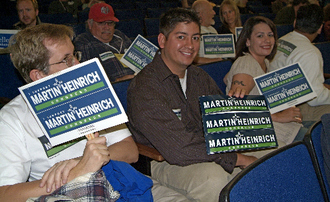
Heinrich supporters at Saturday's DPNM SCC Meeting
The lastest from Martin Heinrich's campaign for Congress in NM-01:
Heinrich: "My campaign is about changing the way Washington works, and I am proud to have the Pueblo's support as we move forward"
Albuquerque City Councilor and Democratic candidate for Congress Martin Heinrich picked up another endorsement today in his campaign to bring change to Washington. The Pueblo of Zia –- the first pueblo to endorse any candidate in the race –- has endorsed his bid to represent New Mexico's First Congressional District.
"Martin Heinrich has proven he is an effective advocate on tribal issues. He worked side by side with the Pueblo of to protect the Ojito Wilderness and to return critical ancestral lands to the Pueblo. We know he'll be a Congressman who understands the unique concerns of our Pueblo," said Governor Rudy Shije.Zia
"It is an honor to have the backing of a pueblo so fundamental to New Mexico's past, present and future," Heinrich said. "Just as the people of Zia believe that helping others is a sacred obligation, I believe that government should focus on helping the people instead of helping itself. My campaign is about changing the way Washington works, and I am proud to have the Pueblo's support as we move forward."
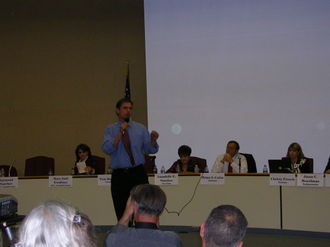
Martin speaks to Dems at Saturday's SCC meeting in Albuquerque
While the Pueblo of Zia is outside the boundaries of District 1, many tribal members reside in the district, especially in Albuquerque. In addition, the Pueblo has a long history of working closely with New Mexico's entire congressional delegation on matters important to the Pueblo and all New Mexicans.
Over the course of the campaign to date, Heinrich has amassed an impressive number of endorsements from community leaders and elected officials across the First District. Heinrich's backers include Albuquerque City Councilors Debbie O'Malley, Michael Cadigan and Isaac Benton, former Bernalillo County Commissioner Steve Gallegos, state Senators Jerry Ortiz y Pino and Cisco McSorley, and state Representatives Antonio "Moe" Maestas, Danice Picreaux, Al Park, Mimi Stewart and Gail Chasey.
For a full list of Martin's endorsements, click here.
You can contribute to Heinrich's campaign at the DFNM Netroots for Heinrich page at Act Blue or volunteer by calling his campaign office at 505.244.0022, located at 2118 Central Avenue SE, #71, in Albuquerque.
To see our previous coverage of the NM-01 Congressional race, visit our archive.
November 9, 2007 at 12:45 AM in Native Americans, NM-01 Congressional Seat 2008 | Permalink | Comments (1)
Saturday, September 15, 2007
Lastest Developments on Desert Rock Power Plant: EIS Problems and Fluor Corp.
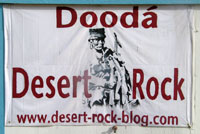 Recent news about Desert Rock, the controversial coal-fired power plant proposed on Navajo Nation land near Shiprock, NM, centers on U.S. Environment Protection Agency (EPA) concerns about the project's Draft Environmental Impact Statement prepared by the Bureau of Indian Affairs (BIA), as well as the award of the initial program management contract to Fluor Corp., a major player implicated in the Iraq and Katrina recovery contract scandals.
Recent news about Desert Rock, the controversial coal-fired power plant proposed on Navajo Nation land near Shiprock, NM, centers on U.S. Environment Protection Agency (EPA) concerns about the project's Draft Environmental Impact Statement prepared by the Bureau of Indian Affairs (BIA), as well as the award of the initial program management contract to Fluor Corp., a major player implicated in the Iraq and Katrina recovery contract scandals.
Problems with Draft Environmental Impact Statement
The U.S. EPA is questioning the sufficiency and accuracy of the draft environmental impact statement on the plant, which would be built by Houston-based Global Sithe in cooperation with the Navajo Nation. According to an article in today's Albuqurque Journal:
The EPA questions some of the numbers and projections in a Bureau of Indian Affairs draft environmental impact statement, which was released this summer and was the focus of 10 public hearings across the Four Corners and in Albuquerque and Santa Fe.
... In a 12-page analysis of problems with the environmental impact assessment, the EPA notes "unresolved concerns" with the BIA's analysis of groundwater contamination and air quality effects of the construction and operation of the 1,500-megawatt plant.
Representatives of Diné C.A.R.E., the San Juan Citizens Alliance and the Energy Minerals Law Center issued a joint press release dated September 12, 2007 in response to the EPA's comments. Excerpt:
"We commend EPA's recognition that Desert Rock presents unresolved environmental justice issues. The two existing power plants and three coal mines in the region have created a legacy of disproportionate impacts to the Diné people," said Dailan Long of Diné Citizens Against Ruining our Environment (C.A.R.E.), "Like its predecessors, Desert Rock will result in the permanent removal and relocation of Navajo Nation tribal members including elders many of whom only speak Navajo, do not have phones, electricity or running water, and use these areas for ceremonial, customary and medicinal purposes. The BIA and industry have to date failed to treat local Diné people humanely."
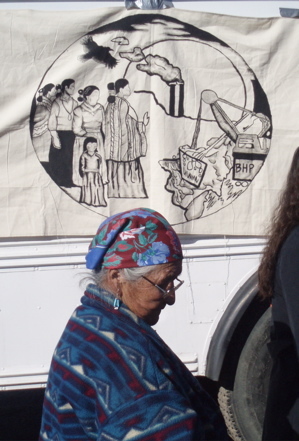
"The EPA rightfully notes that the DEIS for Desert Rock fails to evaluate the impacts of continued dumping of coal combustion wastes in Navajo Mine with no valid conclusion concerning the legacy of dumping practices in the region." said Brad Bartlett, attorney with the Energy Minerals Law Center. "Tens of millions of tons of hazardous coal combustion waste have already been dumped in the existing Navajo Mine from the existing Four Corners Power Plant. Desert Rock would expand the Navajo Mine by 17,000 acres and increase the unmitigated dumping of these wastes ten fold."
"The EPA comments on the Desert Rock DEIS reinforce unresolved environmental and economic problems for Sithe Global's proposal," said Mike Eisenfeld of the San Juan Citizens Alliance. "The notion that Desert Rock is a clean coal-fired power plant has been clearly refuted. It is now time for the BIA and the Navajo Nation to move beyond the ill-advised, conceptual Desert Rock project to economic development for the Navajo Nation that truly accounts for economic and environmental progress and success."
EPA's comments include the unevaluated impacts to groundwater from continued and expanded Coal Combustion Byproducts (otherwise known as coal combustion waste) disposal in Navajo Mine (the proposed source of coal for Desert Rock); the failure of BIA to require aquifer testing and impact assessment; the lack of a groundwater monitoring program for the project; deficient conclusions concerning groundwater; insufficient particulate matter emission calculations for air quality impacts; improper conclusions concerning mercury content of coal proposed to be burned for Desert Rock; and failure to include a public health discussion that includes the latest scientific information about air pollution and public health, including impacts from ozone.
In addition, the EPA documented several deficient Environmental Justice issues including lack of local citizen access to power and no proposed mitigation in the DEIS; the failure to identify information concerning potential relocation of minority and low income populations as a result of Desert Rock; and the failure to properly evaluate the potential impacts of Desert Rock on groundwater and agriculture.
"Disaster Profiteer" Fluor Corp. to Manage Development
Fluor Corp., a generous contributor to Republican candidates, was selected to provide initial comprehensive program management services in the development of Desert Rock starting in 2008. Fluor was also the recipient of $100 million in no-bid contracts from FEMA for services in the Katrina recovery effort. FEMA's entire contracting process is being audited by the Department of Homeland Security after complaints from Congressional Democrats and others about cronyism and serious mismanagement.
According to a September 2005 article by the Institute of Southern Studies, the corporation has also been heavily involved in questionable and costly Iraq recovery projects and other boondoggles:
A California-based engineering firm, Fluor has been one of the government's biggest go-to contractors for overseas engineering work, accumulating contracts worth $8.5 billion (source: The Center for Public Integrity) from 1990 to 2002. Iraq was no exception, where they pointed to their long history in the region (mostly Saudi Arabia) to land over $1.6 billion in contacts for rebuilding Iraq. According to an August 2004 report in the Los Angeles Times, they also had the right political connections:
Suzanne H. Woolsey is a trustee of a little-known arms consulting group that had access to senior Pentagon leaders directing the Iraq war. In January, she joined the board of Fluor Corp. Soon afterward, Fluor and a joint-venture partner won about $1.6 billion in reconstruction contracts in Iraq.
Woolsey's husband, the former CIA director, R. James Woolsey, a leading advocate for the war, also serves as a government policy adviser. He, too, works for a company with war-related interests.
The Woolseys' overlapping affiliations are part of a pattern in Washington, in which individuals play key roles in organizations advising officials on major policy issues, whileinvolving themselves with businesses in related fields.
What's their work record? Like many of the politically-connected contractors, Fluor keeps landing contracts despite a long rap sheep of scandal and abuse, including repeated claims of overcharging and gouging taxpayers. Among the most recent include charges of falsely claiming millions of dollars in costs on DoD contracts in 2001 (the company settled for $8.5 million), and in 2002 being sued for $24 million for "numerous design and construction failures" at the Refugio Mine in northern Chile.
And their work state-side? In 1994, Fluor paid a $3.2 million fine for "submitting heavily padded repair bills for work on Navy bases after hurricane Hugo."
In addition,
Fluor manages the government's Hanford Nuclear Reservation in Washington, one of the most heavily polluted sites in North America. Since Fluor took over the site in the mid-1990s, workers and local citizens have charged the company with cost cutting measures that have created potential environmental and health concerns. The company responded by firing whistleblowers and shutting down the Hanford Joint Council, a public forum established eight years ago to air employee and local government concerns over plant safety. (Ref: Gov. Accountability Project)
As reported in the New York Times, Fluor Corp. as an entity within the Fluor comglomerate, was incorporated in Delaware on September 11, 2000 after splitting with their coal production unit, which is now called Massey Energy. Massey is the nation's fourth largest coal producer according to CorpWatch.
 State of NM Seeks Consultation with Navajo Nation
State of NM Seeks Consultation with Navajo Nation
In late July 2007, Gov. Bill Richardson issued a statement expressing his serious concerns about the Desert Rock Plant due to the significant amounts of greenhouse gases and other pollutants the plant would emit. In a letter dated August 20, 2007 to Navajo Nation President Joe Shirley, Jr., Richardson requested "formal government-to-government consultation between the State of New Mexico and the Navajo Nation" to discuss the concerns and explore options for addressing them. Ron Curry, Secretary of the NM Environment Department, was designated as the State's lead person in the consultation. No word yet on a response from President Shirley.
Still Time to Submit Comments
Gov. Richardson also requested an extension of the comment period on the project's draft environmental impact statement and others have complained about the short time allowed for public input. The comment period, in fact, has been extended and now ends on October 9, 2007. You can electronically submit comments on the project to www.desertrockenergy.com. There is a 40,000 character limit. It's recommended that you also mail a copy of your comments to:
Harrilene Yazzie, NEPA Coordinator
Bureau of Indian Affairs, Navajo Regional Office
P.O. Box 1060, Gallup, New Mexico 87305
505-863-8287
To learn more about the Desert Rock Power Plant controversy and stay current on developments, visit the desert-rock-blog operated by Doodah Desert Rock activists, the San Juan Citizens Alliance website and the website of the Rio Grande Chapter of the Sierra Club.
Also check out the indepth commentary in this previous post, which includes links to our past Desert Rock coverage.
September 15, 2007 at 02:34 PM in Corporatism, Crime, Energy, Environment, Local Politics, Native Americans | Permalink | Comments (0)
Friday, September 14, 2007
Guest Blog: We Didn't Cross Any Borders, They Crossed Us
This is a guest blog by JaciCee that originally appeared as a diary on Daily Kos:
Okay, maybe we did cross a couple of borders. We marched up through Central America and Mexico and entered Native American land when we first settled here. But since the early 1600's we haven't moved. Who are we? The first families and explorers that settled into New Mexico. You know, that state that sets between Texas and Arizona and is north of Mexico and under Colorado. We are actually part of the United States and have been since 1912. Many Americans don't know that. In case you don't believe me, check this out. One of our local publications features stories about misperceptions and flat out ignorance about our state.
Let's talk a little about what happened before we became a state in 1912. I'll give you a quick historical rundown but if you want more on our state's rich history, go here or here.
The Native American cultures were thriving here when the Spaniards first arrived. Those incredible cultures date back to at least 1100 A.D. The first Europeans arrived in New Mexico with Francisco Vasquez de Coronado's expedition in 1540. Up until 1821 we lived under the Spanish flag. In 1821 Mexico acquired New Mexico from Spain. We then lived under the Mexican flag until 1846 when we fell under US control. In 1862 Albuquerque surrendered to the South during the Civil War. In 1912 we officially became a state. We have lived under three flags without going anywhere.
Some of our families had relatives living south of the New Mexican territory. The borders were open. We could travel all over and see who we liked. These relationships still exist today.
Why does this matter? My family arrived here in 1603. They came here with other families. They married other Spaniards, Indians and Mexicans. They created an incredibly diverse human landscape that is still thriving today. These same families, whether they live in Albuquerque, Las Cruces, Santa Fe, Espanola or Taos still speak Spanish in their homes. Many still have accents. They are Americans. They are dark, light, tall, short, skinny and fat. They have brown eyes, blue eyes and green eyes. Many outsiders can't tell the difference between a sixth generation New Mexican or an illegal immigrant.
I have been somewhat silent about the immigation debate. I have some pretty strong views about it but not until I saw this yesterday did I become absolutely enraged.
Some local Republicans have decided it is cool to drive a billboard around Albuquerque with the slogan "Mayor Chavez's sanctuary city for criminal illegal immigrants!" They are pissed off because Mayor Chavez refuses to use the Albuquerque Police Department to round up "illegal aliens." According to Allen Weh, a local Republican:
"We’re talking about public safety, and in the area of public safety, my view and our view is it’s a non-negotiable item, we’re all in this together, we all live in this city, we all live in this state, and our families should be safe,"
Safety? I would like to see some hard facts from Mr. Weh about how many crimes are committed by illegal immigrants in New Mexico. But I doubt any New Mexican will get any facts from hatemongers. I don't call them hatemongers lightly either. Look at the message they are currently driving around a major US city that has a huge Hispanic population. They are associating the workers they depend on to manicure their lawns, clean their houses, work on their roofs, care for their children, clean their hotel rooms, wash their dishes, cook their food, pick their chile crops to the level of a criminal. I feel bad for the children of the shadow workers, who on their way to school, have to watch a billboard rolling by on a publicly funded street that equates their mother or father to a murderer.
I feel worse though that Republicans, like Weh, think they have a right to be abusive and uninformed towards a population that they know nothing about. I am sure Weh could not tell an American citizen from an illegal in this state.
Kudos to Mayor Marty for standing firm on this.
"And I will not have the police stopping Americans based on the color of their skin, so they need to get off it and help our congressional delegation find meaningful solutions to our immigration dilemma," said Mayor Martin Chavez.
That is my greatest fear; that someday somebody who has moved to New Mexico from a flyover state will question me or my children about our citizenship. My family has been here for multiple generations. Each of those generations has produced family members who served our nation during times of war.
Before you consider immigration reform, please think about how any of those reforms will affect American citizens, like me.
Editor's Note: This is a guest blog by JaciCee. It was originally posted as a diary on Daily Kos.
Guest blogs provide our readers with an opportunity to express themselves and may or may not represent our views. If you'd like to submit a post for consideration as a guest blog, contact me by clicking on the Email Me link on the upper left-hand corner of the page.
September 14, 2007 at 01:15 PM in Crime, Guest Blogger, Immigration, Local Politics, Minority Issues, Native Americans | Permalink | Comments (3)
Saturday, September 08, 2007
News from SAGE Council
From SAGE Council:
Jam the Ballot Box Music Fest! Get Out the Vote! The Jam the Ballot Box music fest is an all ages show featuring four Native American rock bands. Come rock out as we celebrate Native voters! Call JR at 260-4696 if you are interested in volunteering at the event!
What: Jam the Ballot Box music fest
When: Saturday, September 15th, 7 PM
Where: The Compound, 3206 San Mateo NE, ABQ
Cost: $10
Native American Voters Alliance (NAVA): Get Out the Vote! Water & Urban Indian Healthcare. NAVA is off to a good start, but we need your help to make it a success! This year, we're concentrating on two issues: water, and urban Indian healthcare.
Water: Currently, Albuquerque uses an unsustainable amount of water. We are exceeding our yearly water budget by at least 18 billion gallons of precious and non- renewable groundwater. We must protect water availabilty for future generations!
Native American healthcare: Although NAVA was successful in securing funding for Urban Indian healthcare earlier this year, it is clear that much more needs to be done to ensure quality, accessible healthcare for Native Americans!
We need your help to get out the Native vote! Come with us as we go out into our community to make positive change! We phonebank Monday-Thursday from 6:00-8:00 PM and we're going doorknocking Saturday and Sunday from10 AM - 1 PM. Call the office at 260-4696 to sign up to volunteer!
We Made Our Debut at NACA! SAGE Council stepped into our first classroom two weeks ago to teach 6th, 7th, and 8th graders the concepts of community organizing. Wow! What an experience! Our class is awesome! The students are truly exceptional and went above and beyond our expectations when we discussed topics like racism and stereotypes. Their knowledge, insight, and ability to see through all the hype was amazing. Our experience so far has been challenging but also very rewarding. We'll keep you updated on how it's going! If you are interested in helping, or if you know of activities that would be fun for the class, please call our office at 260-4696.
Mark Your Calendar for Desert Rock Event! October 5th-7th! Next month after the city elections, SAGE Council will resume our role as supporters of the Dooda Desert Rock (DDR) resistance. DDR has asked SAGE to help with petition-signing and a demonstration at the Shiprock Fair. The details are yet to be confirmed, but SAGE is thinking of taking a caravan or a busload of people from Albuquerque to help gather signatures to oppose the Desert Rock power plant, and to help with the demonstration during the opening parade. Ideas, suggestions, and donations to make this trip possible are greatly appreciated! Call the office if you want to sign up to go with us!
SAGE Council is an Indigenous and people of color-led organization using community organizing to build power through action, education, leadership development and political participation. Our commitment to social change and self determination is based on values that honor the environment and all people. We want to hear from you! Let us know what you think about how we are doing at SAGE. You can sign up for our email newsletter at our website.
SAGE Council Web: https://www.sagecouncil.org
Email: sage@sagecouncil.org
Phone: 505-260-4696
September 8, 2007 at 10:16 AM in Election Reform & Voting, Healthcare, Local Politics, Minority Issues, Native Americans | Permalink | Comments (0)


























